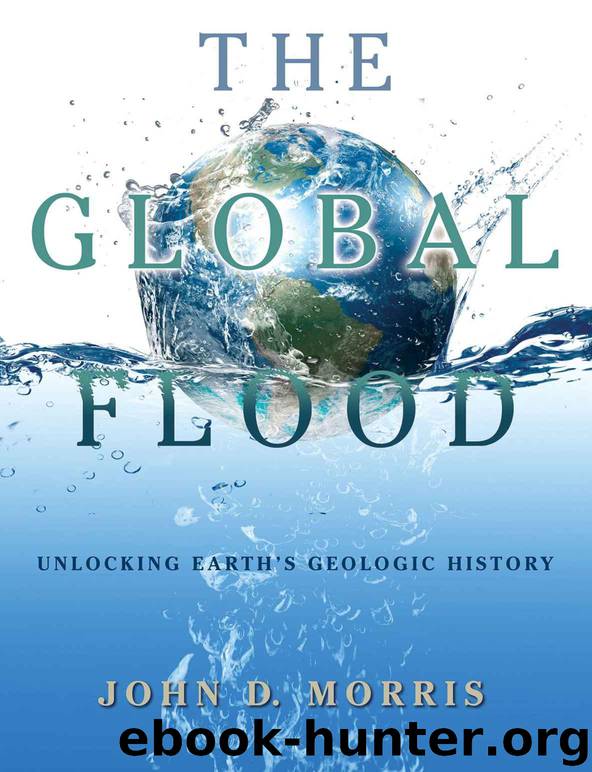The Global Flood: Unlocking Earth's Geologic History by Morris John D

Author:Morris, John D. [Morris, John D.]
Language: eng
Format: mobi
ISBN: 9781935587316
Publisher: Institute for Creation Research
Published: 2013-06-16T16:00:00+00:00
HOW COULD FISH SURVIVE
Noah’s Flood?
If such a flood took place, it would have laid down multiple layers of mud full of the remains of plants and animals that died in the Flood. These layers would be widespread (since the Flood was global) and give evidence of having been laid down rapidly.
The Flood was not only an episode of judgment; it was also a time of God’s grace and salvation. Noah and his family, and two representatives of each “kind” of land-dwelling, air-breathing animal (seven of each “clean” kind), were protected and preserved on board Noah’s Ark. Outside, “all in whose nostrils was the breath of life, of all that was in the dry land, died” (Genesis 7:22).
But what about the fish and other marine creatures? Obviously, they weren’t taken on board the Ark. How could they survive, particularly both fresh and saltwater forms? As a matter of fact, most of them didn’t survive. Over 95 percent of all fossils are marine creatures. They died, and were fossilized by the trillions. Many are buried in great fossil graveyards, tightly packed together, choked with sediments, buried before they had time to decay. Obviously, they didn’t live in the environment in which they died. But how could any have survived?
In the complex of events and conditions that made up the Flood, certainly there were pockets of fresh and/or clean water at any one time. Remember, it was raining in torrents, and we can expect that the rain was fairly fresh water. Many studies have shown that waters of various temperatures, chemistries, and sediment loads do not tend to mix; they tend to remain segregated into zones. It would be unlikely for any one area to retain such zones for very long during the tumult of the Flood, but on a worldwide scale, some such segregated zones would have existed at any given time. Furthermore, we don’t know the tolerance levels of pre-Flood fish for sediment, salt, and temperature. Modern fish have a great variety of responses to different environments. Perhaps before the Flood, fish were even more adaptable.
There is also the possibility that great amounts of vegetation were dislodged from their pre-Flood locations and remained intertwined during the Flood as floating mats. Many creationists suggest that the decay and abrasion of these mats are responsible for many of our major coal seams, but underneath these mats, the turbulence of the surface would have been lessened. Perhaps many fish found shelter and nutrition under them, as insects may have on the mats themselves.
Even though there is much we don’t know about what went on during the Flood, we can see that there is at least a plausible answer that can be proposed to such questions.
Download
This site does not store any files on its server. We only index and link to content provided by other sites. Please contact the content providers to delete copyright contents if any and email us, we'll remove relevant links or contents immediately.
| Guides | New Testament |
| Old Testament |
The Five People You Meet in Heaven by Mitch Albom(3474)
The Secret Power of Speaking God's Word by Joyce Meyer(2968)
Real Sex by Lauren F. Winner(2966)
Name Book, The: Over 10,000 Names--Their Meanings, Origins, and Spiritual Significance by Astoria Dorothy(2938)
The Holy Spirit by Billy Graham(2892)
0041152001443424520 .pdf by Unknown(2783)
ESV Study Bible by Crossway(2732)
How The Mind Works by Steven Pinker(2729)
Ancient Worlds by Michael Scott(2622)
Churchill by Paul Johnson(2505)
The Meaning of the Library by unknow(2503)
The ESV Study Bible by Crossway Bibles(2502)
The Gnostic Gospels by Pagels Elaine(2468)
MOSES THE EGYPTIAN by Jan Assmann(2372)
Jesus by Paul Johnson(2309)
City of Stairs by Robert Jackson Bennett(2307)
The Complete Dead Sea Scrolls in English (7th Edition) (Penguin Classics) by Geza Vermes(2232)
Ancient Near Eastern Thought and the Old Testament by John H. Walton(2195)
The Nativity by Geza Vermes(2179)
